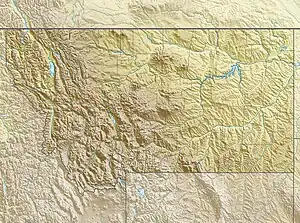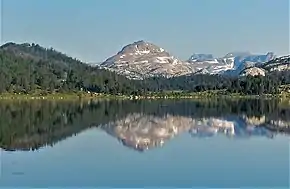| Lonesome Mountain | |
|---|---|
 South aspect | |
| Highest point | |
| Elevation | 11,399 ft (3,474 m)[1] |
| Prominence | 1,039 ft (317 m)[1] |
| Parent peak | Spirit Mountain (12,283 ft)[2] |
| Isolation | 2.43 mi (3.91 km)[2] |
| Coordinates | 45°00′51″N 109°35′43″W / 45.0142833°N 109.5951923°W[3] |
| Geography | |
 Lonesome Mountain Location in Montana  Lonesome Mountain Lonesome Mountain (the United States) | |
| Location | Carbon County, Montana, U.S. |
| Parent range | Rocky Mountains Absaroka Range Beartooth Mountains |
| Topo map | USGS Silver Run Peak |
| Climbing | |
| Easiest route | class 3 scrambling[2] |
Lonesome Mountain is an 11,399-foot (3,474-metre) mountain summit located in Carbon County, Montana.[3]
Description
Lonesome Mountain is located in the Beartooth Mountains, which are a subset of the Rocky Mountains. It is situated 4.2 miles north of Beartooth Butte in the Absaroka-Beartooth Wilderness, on land managed by Gallatin National Forest. The highest point in Montana, Granite Peak, rises 14.3 miles to the northwest. Precipitation runoff from the mountain drains into several surrounding alpine lakes which feed tributaries of the Clarks Fork Yellowstone River. Topographic relief is significant as the summit rises 1,400 feet (430 meters) above these lakes in less than one mile. This geographical feature's name has been officially adopted by the United States Board on Geographic Names.[3]
Climate

Based on the Köppen climate classification, Lonesome Mountain is located in a subarctic climate zone characterized by long, usually very cold winters, and mild summers.[4] Winter temperatures can drop below −10 °F with wind chill factors below −30 °F.
See also
References
- 1 2 "Lonesome Mountain, Montana". Peakbagger.com. Retrieved 2021-11-17.
- 1 2 3 "Lonesome Mountain - 11,420' MT". listsofjohn.com. Retrieved 2021-11-17.
- 1 2 3 "Lonesome Mountain". Geographic Names Information System. United States Geological Survey, United States Department of the Interior. Retrieved 2021-11-17.
- ↑ Peel, M. C.; Finlayson, B. L.; McMahon, T. A. (2007). "Updated world map of the Köppen−Geiger climate classification". Hydrol. Earth Syst. Sci. 11: 1633–1644. ISSN 1027-5606.
External links
- Weather forecast: Lonesome Mountain